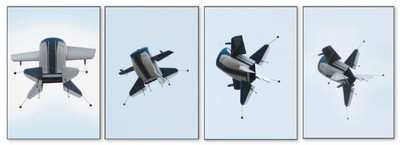Unique UAS Transitions From Vertical To Horizontal Flight
Aero-News received word
Tuesday from Aurora Flight Sciences that the company's GoldenEye-50
unmanned aerial system (UAS) completed its 100th flight earlier
this month, during a 22-minute flight at the company’s flight
test facility. GoldenEye-50 is unique among current ducted fan
UAVs, because it is able to take off vertically, autonomously
transition to high-speed wingborne flight and then return to hover
flight in the target area to collect imagery and sensor
readings.
Aurora’s GoldenEye team is now focused on transforming the
aircraft into a ruggedized platform that can operate in both land
and marine environments. GoldenEye-50 was designed as a technology
development platform for Aurora's larger ducted fan aircraft, the
GoldenEye-OAV. GoldenEye-50 was instrumental in the development of
the flight control system and acoustic signature reduction for
Aurora’s GoldenEye-OAV program.
"The GoldenEye-50 has done a tremendous job as the technology
pathfinder for our OAV entry," said Aurora president John S.
Langford. "There has been significant interest in the GoldenEye-50
as a stand-alone product and we now plan to pursue that.
GoldenEye-50 will offer advanced capability to units smaller than
the company-sized units GoldenEye-OAV is designed to
accompany."
The upgraded vehicle, known as GoldenEye-50 Block II, will have
many common traits with the Block I aircraft, but will feature
several upgrades including an advanced imagery suite, an enhanced
engine, increased endurance and compatibility with General Dynamics
Robotic Systems Soldier Machine Interface.
GoldenEye-50 made its first flight in July of 2004, and made its
first autonomous transition to and from horizontal flight in April
of 2005. Since April, the rapidly maturing system has demonstrated
superior acoustic performance that surpasses DARPA's OAV-II
requirement and the ability to perform high-speed banked turns
during wingborne flight. During the summer of 2005, GoldenEye
demonstrated its capabilities to Army Ranger, Cavalry and Artillery
and the forces of a NATO country.

Aurora plans to deliver Block II production units by early
2007.
The GoldenEye family consists of the GoldenEye-50 and the larger
GoldenEye-OAV. Both share common flight control algorithms,
aerodynamics, low observability features, and compatibility with
the GDRS soldier-machine interface. The GoldenEye-50 uses a small
gasoline engine, while the GoldenEye OAV uses a heavy fuel engine.
GoldenEye-OAV also carries an advanced collision avoidance system,
which will allow it to operate at low altitudes and in urban
environments.
Both GoldenEye versions can be carried in the back of an
unmodified Humvee and requires neither launch nor recovery
equipment. Aurora says GoldenEye also has greater range than
similarly sized VTOL UAS, because GoldenEye's wings enable
high-speed flight and allow it to cover more territory while
burning less fuel than wingless VTOL UAS that must hover toward the
target area.
 Sierra Space Repositions Dream Chaser for First Mission
Sierra Space Repositions Dream Chaser for First Mission ANN's Daily Aero-Term (05.10.24): Takeoff Roll
ANN's Daily Aero-Term (05.10.24): Takeoff Roll Aero-News: Quote of the Day (05.10.24)
Aero-News: Quote of the Day (05.10.24) Aero-News: Quote of the Day (05.11.24)
Aero-News: Quote of the Day (05.11.24) ANN's Daily Aero-Term (05.11.24): IDENT Feature
ANN's Daily Aero-Term (05.11.24): IDENT Feature



